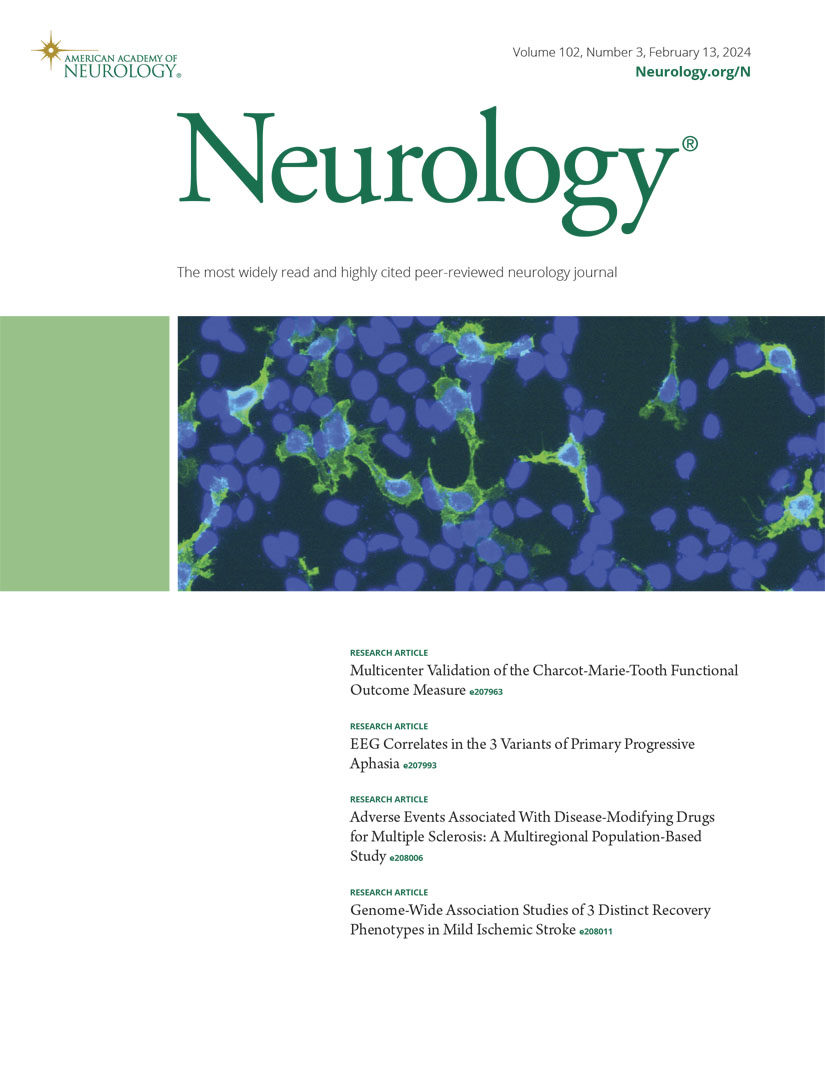Pearls & Oy-sters: Arterial Wall Enhancements and Rapid Clinical Progression in Noninflammatory Cerebral Amyloid Angiopathy.
IF 7.7
1区 医学
Q1 CLINICAL NEUROLOGY
引用次数: 0
Abstract
Cerebral amyloid angiopathy (CAA) is a common cause of lobar intracerebral hemorrhage (ICH) and cognitive impairment for which diagnostic criteria have been recently revised. A subset of CAA cases have superimposed inflammation in the form of CAA-related inflammation, which may result in a more severe clinical course. We present the case of a 61-year-old man who presented with subacute behavioral changes, motor aphasia, and right hemiparesis due to an ICH in the left superior frontal gyrus. Brain MRI revealed a small chronic cortico-subcortical right occipital hemorrhage and multiple lobar microbleeds, fulfilling the criteria for probable CAA. One year later, he developed acute psychosis with aggressive behavior. β-Amyloid (Aβ) 1-40 and 1-42 levels were reduced in the CSF, with normal total tau and phosphorylated tau. He remained clinically stable during the following years. At age 68, he showed a rapid cognitive deterioration over 6 months, atypical for CAA. Repeat brain MRI showed multiple cortico-subcortical microbleeds and microinfarctions. High-resolution vessel wall MRI showed concentric wall enhancement in multiple arterial segments. These findings raised concerns for an inflammatory process, in the form of either inflammatory CAA or vasculitis. The neuropathologic findings were consistent with severe CAA without vessel wall inflammation. This case highlights the periods of steep progression that may occur in CAA and that Aβ accumulation alone, without inflammation, may be associated with arterial wall enhancement, mimicking a vasculitic or amyloid-related inflammatory process. The value of this neuroimaging feature for patient stratification or prognosis requires further validation.非炎症性脑淀粉样血管病的动脉壁增强和快速临床进展。
脑淀粉样血管病(CAA)是脑叶性脑出血(ICH)和认知障碍的常见病因,其诊断标准最近已修订。一部分CAA病例以CAA相关炎症的形式叠加炎症,这可能导致更严重的临床病程。我们提出的情况下,61岁的男子谁提出亚急性行为改变,运动失语,和右半瘫由于脑出血在左额上回。脑MRI显示右枕皮质-皮质下小范围慢性出血及多发脑叶微出血,符合可能的CAA诊断标准。一年后,他患上了带有攻击性行为的急性精神病。脑脊液中β-淀粉样蛋白(Aβ) 1-40和1-42水平降低,总tau蛋白和磷酸化tau蛋白正常。在接下来的几年里,他的临床表现一直稳定。在68岁时,他表现出6个多月的快速认知退化,非典型CAA。重复脑MRI显示多发皮质-皮质下微出血和微梗死。高分辨率血管壁MRI显示多动脉段同心圆壁增强。这些发现引起了对炎症过程的关注,无论是炎症性CAA还是血管炎。神经病理结果与严重CAA一致,无血管壁炎症。该病例强调了CAA可能出现的急剧进展期,并且无炎症的单独a β积累可能与动脉壁增强有关,模拟血管或淀粉样蛋白相关的炎症过程。这种神经影像学特征对患者分层或预后的价值有待进一步验证。
本文章由计算机程序翻译,如有差异,请以英文原文为准。
求助全文
约1分钟内获得全文
求助全文
来源期刊

Neurology
医学-临床神经学
CiteScore
12.20
自引率
4.00%
发文量
1973
审稿时长
2-3 weeks
期刊介绍:
Neurology, the official journal of the American Academy of Neurology, aspires to be the premier peer-reviewed journal for clinical neurology research. Its mission is to publish exceptional peer-reviewed original research articles, editorials, and reviews to improve patient care, education, clinical research, and professionalism in neurology.
As the leading clinical neurology journal worldwide, Neurology targets physicians specializing in nervous system diseases and conditions. It aims to advance the field by presenting new basic and clinical research that influences neurological practice. The journal is a leading source of cutting-edge, peer-reviewed information for the neurology community worldwide. Editorial content includes Research, Clinical/Scientific Notes, Views, Historical Neurology, NeuroImages, Humanities, Letters, and position papers from the American Academy of Neurology. The online version is considered the definitive version, encompassing all available content.
Neurology is indexed in prestigious databases such as MEDLINE/PubMed, Embase, Scopus, Biological Abstracts®, PsycINFO®, Current Contents®, Web of Science®, CrossRef, and Google Scholar.
 求助内容:
求助内容: 应助结果提醒方式:
应助结果提醒方式:


